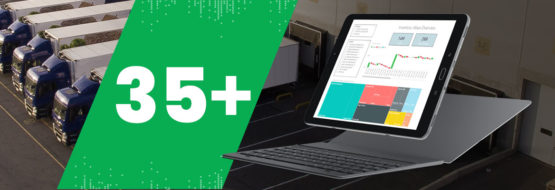Best 40+ Inventory KPIs and Metric Examples for Reporting

Inventory KPIs and metrics are crucial aspects of the reporting process. Any business that holds and distributes stock needs to have the means to track its health and performance.
Inventory KPIs provide businesses with accurate information to make data-driven decisions. They help monitor inventory levels, track deliveries, and provide actionable insights about the efficiency of the warehouse or storage facilities. When gathered correctly, you can also use inventory KPIs to analyze and improve operations.
How to Build Useful KPI Dashboards
Download NowWhy Inventory KPIs and Metrics Are Essential for Reporting?
Good reporting allows you to monitor the health of your operation. Tracking your performance and productivity is instrumental in identifying and improving your process. Here are some of the benefits of using inventory KPIs for reporting:
#1. Improved efficiency
Tracking inventory KPIs and metrics allows businesses to identify areas in their business that need improvement and attention. Metrics help give management the full picture of operations they need to make impactful decisions.
#2. Reduce costs
Supply chain disruption, high inflation, and rising warehouse rental costs have increased operating costs. It’s not always possible to pass these costs onto customers. Tracking KPIs can help reduce outgoings, spoilage, and shrinkage and drive down overheads.
#3. Increase customer satisfaction
Warehouse and distribution efficiency plays a vital role in customer satisfaction. Improving your operations leads to quicker and more accurate turnarounds and deliveries, which in turn
improves customer retention.
#4. Boost employee retention
Employee retention is a pressing issue for many warehouses. The rise of eCommerce has led to a shortage of good warehouse staff, with high turnover rates becoming standard. Tracking safety and employee satisfaction can help create a better environment that both attracts and retains workers.
Below, we’ll share some of the best inventory KPI examples that you can use to measure the performance of your warehouse or facility.
We’ve broken down the inventory KPI examples into five distinct categories:
- Sales inventory KPIs
- Operational inventory KPIs
- Receiving KPIs
- Employee KPIs
- Safety KPIs
Taken individually, they can provide a test of the strength of different phases of your operation. Together, they can give a robust reading of your operation’s health.
Sales Inventory KPIs
1. Product Sales
Product sales are a vital part of reporting. It’s one of the most powerful inventory KPIs.
You can work product sales out with the following formula:
Product sales = gross revenue from sales – (returns + discounts + allowances)
You can run this metric over days, weeks, months, or years. It gives you an idea of the overall profitability of a particular line or your entire stock.
2. Inventory Turnover Ratio
Your inventory turnover ratio measures how fast stock is turned over, typically in a year. However, you can use it over any time frame.
A straightforward way to calculate this metric is by first finding your average inventory value.
You can calculate this by getting:
(opening inventory value + closing inventory value) / 2
Then take that number and work out:
Inventory turnover ratio = (total cost of goods sold / average inventory value)
Inventory turnover is an excellent way to calculate how efficient your inventory management processes are. However, you need to strike a balance. If your turnover rate is too low, it will affect your order fulfillment, leading to a loss of revenue and customers.
3. Stock to Sales Ratio
Stock to sales is one of the best inventory KPIs to help determine optimal stock levels.
Stock to sales ratio = (Units available / Units sold)
Too much inventory costs resources to store, plus you need to consider opportunity costs of capital that you can deploy elsewhere. Again, this is about striking a balance: if the ratio is too low, you will likely run out of stock.
4. Stock Availability
Stock availability is a great inventory management KPI for tracking what percentage of your stock is actually available for customers to purchase.
Stock availability = (stock available to sell / stock in catalog) X 100
Low stock availability could indicate inefficiencies in your warehouse, leading to storage costs that are hurting profits.
5. Days to Sell Inventory / Days on Hand
Days to sell inventory is a good metric for measuring how long you hold inventory, or to put it another way, how long it takes you to sell items.
You can calculate this KPI as follows:
Days to sell inventory = (Average Inventory / Cost of Sales) x 365
The lower the days to sell inventory number, the more efficiently your goods are being moved. Of course, what constitutes a good number depends on what items you sell. It’s worth benchmarking against similar items when deciding if the figure is high. Many high-ticket products sell at a slower rate.
6. Weeks on Hand
Weeks on hand is a good inventory sales metric that is similar to days on hand. You can use it to calculate the rate at which inventory is moving through your warehouse.
The formula is:
weeks on hand = (average inventory / cost of goods sold) x 52
When weeks on hand are high, it implies your inventory is moving too slowly. With storage space occupied, you incur opportunity costs and higher fees. A low week on hand suggests your stock is moving quickly.
7. Backorder Rate
Backorder rate is one of the best inventory metrics for determining how well your fulfillment process works. It measures the percentage of orders that you cannot fulfill. As mentioned above, if this number is high, it will seriously harm your revenues as you miss out on sales.
Backorder rate = (number of undeliverable orders / total number of orders ) x 100
You can use this across your entire line of products or individual items.
8. Rate of Return
The rate of return is one of the simplest KPIs for inventory.
As suggested, it calculates how frequently sold items are returned for a variety of reasons.
To work out this metric, you can use the following formula:
Rate of return = (number of units sold / number of units returned) x 100
Ideally, your rate of return should be as low as possible. However, it’s impossible to keep it at 0%. Some industries and products have higher rates of return than others, like clothing.
Understanding this figure can tell you a lot about which product lines are eating into revenues. Additionally, it can highlight problems with sending out the wrong items too.
9. Sell-through Rate (STR)
The sell-through rate (STR) is one of the best inventory KPIs for measuring the efficiency of your supply chain and evaluating supply chain metrics health. It compares the amount of inventory received from a manufacturer with the amount of inventory sold.
Sell-through rate = (number of units sold / number of units received) x 100
You can measure the sell-through rate weekly, monthly, or annually. It’s an excellent metric for measuring how popular (or unpopular) a particular product is.
Additionally, when combined with storage costs metrics, it can give you a complete picture of the actual costs of holding a particular product.
10. Accuracy of Forecast Demand
Forecasting is a crucial part of reporting. However, you should test these predictions for reliability from time to time. The accuracy of the forecast metric gives you an idea of how confident you can be in your projections of how well a particular item will sell.
Accuracy of forecast demand = [(actual demand – forecast demand) / actual demand] X 100
Understanding the accuracy of forecast demand can help your operation significantly. If you find that your forecast is off considerably, it suggests that you need to review your calculations. If it is off by a low percentage, you can build the difference into your subsequent forecasts.
11. Average Revenue Per Unit
Average revenue per unit is one of the best inventory KPIs for subscription businesses. As the name implies, this inventory KPI can tell you how much income you are generating for each unit.
Average revenue per unit = total revenue for time period / average units sold for time period
You can measure average revenue per unit over weeks, months, or annual. Additionally, it’s a useful metric for subscription businesses to see how much revenue each user or subscription brings in.
12. Cost Per Unit
Cost per unit is one of the strongest inventory KPIs for businesses that either make or sell a large amount of a particular item. You can also use it if your organization orders and sells custom-made items.
Cost per unit = (fixed costs + variable costs) / number of units produced
You can use cost per unit in conjunction with other metrics to calculate revenue and overall financial health. For businesses who primarily sell one product, it’s an essential reporting KPI.
13. Gross Margin by Product
Gross margin by product is one of the most helpful inventory KPIs for measuring profits on a product-by-product basis.
Gross margin by product = [(net sales of product – cost of product) / net sales of product] x 100
This metric is flexible enough that you can use it to evaluate gross margins on items your business produces or buys. When combined with the number of units sold, gross margin by product can indicate if holding a particular product is worthwhile.
Similarly, it can reveal which items you could benefit from promoting more extensively.
14. Gross Margin ROI
Gross margin return on investment (ROI) is one of the best inventory metrics for understanding the efficiency of buying and selling products. Essentially, it measures how much revenue a business makes compared to the amount of money it invests in products.
Gross margin ROI = gross margin / average inventory costs
Calculating gross margin ROI can help you decide which products or lines are over or underperforming. This information can help you decide on future investment strategies.
15. Customer Retention/Loyalty
Acquiring new customers is far more expensive than retaining your current user base. Focusing on your existing customers is an essential strategy for measuring the overall performance of your service.
You can calculate customer retention with the following formula:
Customer retention/loyalty = [(customers at end of period – customers acquired) / customers at start of period) / 100
While inventory managers aren’t wholly responsible for customer retention, they have a critical role to play in the customer’s overall happiness. Low retention rates should be investigated and remedied where possible.
5 Things Not to do When Choosing a Financial Reporting Tool
Download NowOperational Inventory KPIs
16. Production Lead Time
Product lead time is one of the most helpful inventory metrics. It measures the amount of time between placing a purchase order and receiving the item.
You can calculate lead time using the formula:
Production lead time = purchase order procession time + production time + purchase order fulfillment time + supply chain delay
Of course, depending on which goods you sell, production time might not be applicable. Ideally, the lead time should be as low as possible. However, the number will vary based on the complexity of products, especially custom-ordered goods.
Many manufacturers require down payments on a purchase order. Long production times mean this capital is tied up, which means you incur an opportunity cost.
17. Perfect Order Index
The perfect order index is one of the best inventory management KPIs for evaluating customer satisfaction. It measures what percentage of orders go out without delays, damage, or inaccuracies. While 100% is challenging to achieve, it should be the goal for every company.
Perfect order index = (% of orders delivered on time X % of orders complete X % of orders damage-free X % of orders with accurate documentation) x 100
A low perfect order index suggests serious issues. Each individual component should be examined and reviewed regularly to improve the efficiency of your process.
18. Inventory Shrinkage
Inventory KPIs, like inventory shrinkage, are excellent measures of the performance of the warehouse. Essentially they measure the difference between expected and actual stock levels.
Inventory shrinkage = (recorded Inventory – actual Inventory) / recorded Inventory
A high inventory shrinkage rate can indicate several things. For example:
- inadequate accounting
- lost or misplaced inventory
- theft
- damage
Any of the above suggests wasted money. A high rate should trigger an investigation to stem the damage to revenue.
19. Deadstock
Deadstock is a valuable inventory KPI for calculating unsold stock that is unlikely to find a buyer in the future. Excess deadstock is bad for business as it represents capital that has been wasted and incurs storage costs.
Deadstock = expected or average product lifestyle vs. time in inventory
When time in inventory goes over the threshold, it is at risk of being classified as deadstock. When combined with market research on specific products, an excess can suggest this product won’t shift.
20. Safety Stock
Some KPIs for inventory help define how well your business can defend itself against the unexpected. Sometimes particular items experience a surge in demand or supply chain disruption.
Inventory forecast numbers are meant to predict demand. However, they can’t always account for factors outside your control. Supply-chain disruption since the COVID-19 pandemic is one such example.
You can calculate these KPIs for inventory uses the following formula:
Safety stock required = (max daily usage x max lead time) – (average daily usage x average lead time)
Understanding this number allows businesses to gauge how much extra stock they need on hand to ensure they don’t run low on supply and miss out on revenues or cause low customer satisfaction levels.
21. Order Accuracy
Order accuracy is one of the best inventory KPIs for tracking how well your warehouse is doing at picking, packing, and dispatching orders.
To calculate this number, use this formula:
Order accuracy = (number of accurately fulfilled orders / total number of orders) x 100
You can use this formula to determine your overall accuracy or the accuracy of individual pickers.
22. Holding Costs
Holding costs is one of the most critical inventory KPIs. It is a measure of how much it costs to store and protect unsold stock. Calculating this metric is key to defining the fundamentals of your operation.
There are two primary choices an inventory business needs to make:
- Renting their own warehouse
- Using a third-party fulfillment center
Working out the holding costs for both is a big part of making those choices.
Inventory holding costs = (storage Costs + worker salaries + opportunity costs + depreciation costs) / total value of annual inventory
There are several different ways that businesses can lower these costs. Renting your own warehouse and staff can be more cost-effective for more significant operations.
23. Lost Sales Ratio
Lost sales ratio is one of the best inventory management KPIs for measuring whether you are running to lean on stock. The metric looks at how many days a particular item is out of stock compared to the expected sales of the product.
Lost sales ratio = (total number of days a product is out of stock / 365) X 100
While running a lean supply chain eliminates holding costs, a high lost sales ratio can indicate an overly cautious approach. Additionally, being out of stock can cause a dip in consumer confidence and even drive customers to a competitor.
Using the lost sales ratio in conjunction with gross profit per item and costs to hold inventory can help you decide how much stock you should hold.
24. Service Level
Service level measures the percentage of customers who aren’t affected by out-of-stock issues.
Service level = (number of orders delivered / number of orders received) / 100
This metric is important for calculating how well your business can balance inventory storage costs with lost sales.
25. Average Inventory
Average inventory is a way to measure how much stock you have on hand over a particular period.
Average inventory = (inventory at start of period + inventory at end of period) / 2
Average inventory is one of the most straightforward inventory management KPIs for ensuring consistent stock levels. While even levels are essential, some seasonal businesses can tolerate variation.
26. Customer Satisfaction Score (CSAT)
A customer satisfaction score (CSAT) is a simple yet effective inventory KPI for judging how happy your customers are with your overall service. You can get these numbers by asking customers to respond to surveys or by compiling online ratings.
Customer satisfaction score = (number of positive response / total number of responses) X 100
A low customer satisfaction score indicates problems with your processes. Negative responses should trigger a review that seeks to remedy specific issues highlighted by customers.
27. Percentage of Sold Products Within Freshness Date
The percentage of sold products within freshness dates is a handy inventory management KPI for businesses that sell perishable goods. You can use this metric over a specific time period to help determine accurate stock levels and reduce spoilage and waste.
Percentage of sold product within freshness date = (items sold within expiry data / total items sold) X 100
A low percentage of inventory sold within the freshness date clearly indicates that your demand forecast is inaccurate. As well as wasting precious storage space, you are losing money by discarding expired goods.
To remedy this issue, calculate a safety stock buffer and reduce the number of items bought to a satisfactory level.
28. Percentage of Warehouse Occupancy
Percentage of warehouse occupancy is an essential inventory KPI metric for measuring the ROI of your investment in your facility.
Warehouse occupancy rate = (sq ft of warehouse space used / total warehouse sq ft) X 100
If your occupancy rate is low, it suggests that you aren’t making full use of your warehouse capacity. You should monitor this metric carefully because you are still paying for the unused space. The total percentage could also indicate you need a smaller or larger facility.
Receiving KPIs
29. Time to Receive
The time to receive metric is related to production lead time. Where lead time measures the overall process, time to receive looks at your end of the task: taking in the goods.
Time to receive = (time for stock validation + time to add stock to records + time to prep stock for storage)
This inventory metric is vital for measuring your part of the process. Again, a lower time is better. Anything excessive could signify wasted work hours or significant inefficiencies in your approach.
30. Put Away Time
Put away time refers to how long a particular stock takes to be put away (in minutes and hours) after being received and prepped.
Put away time = total time to store received stock
When used with production lead time and time to receive, you have a granular way to look at your entire stock receiving process.
This data can power improvements in your process by helping identify bottlenecks.
31. Putaway Accuracy Rate
Putaway accuracy rate is a good inventory management KPI for measuring your putaway process. It measures the percentage total of items that are stored accurately.
Putaway accuracy rate = inventory put away accurately / total inventory put away
Ideally, this number will be close to 1 or 100%. A low putaway accuracy indicates inefficiencies that likely cost you work hours in finding misplaced inventory.
32. Fill Line Rate
Fill line rate is one of the best inventory metrics for monitoring both order fills, and line fills.
Fill line rate = [(number of total items – number of shipped items) / number of total items] X 100
Fill line rate is an excellent way to measure your order fulfillment process. You can use it to measure the performance of a single delivery or overall delivery.
33. Receiving Efficiency
Receiving efficiency is one of the best inventory management KPIs for measuring the productivity of your workforce.
Receiving efficiency = volume of received inventory / number of staff hours
A low receiving efficiency is a sign that your stock receiving process needs to be reviewed or your staff needs support or extra training.
34. Order Cycle Time
Order cycle time is one of the better inventory management KPIs for measuring how long a business takes to fulfill a customer order.
Order cycle time = (time order was received by the customer – time customer placed the order) / total number of shipped orders
This metric provides a sound oversight of your overall process. It can provide valuable insights into how well your warehouse can meet customer demands while also taking into account delivery and shipping metrics.
35. Cost of Receiving Per Line
The cost of receiving per line is an excellent inventory KPI for understanding the amount of time invested in receiving items from vendors. It factors in the handling and recording of each item.
Cost of receiving per line = total cost of receiving / total number of line items
A high cost of receiving per line could indicate inefficiencies in your supply chain or problems with staff or vendors.
36. Receiving Cycle Time
Receiving cycle time is one of the most useful inventory management KPIs for evaluating the overall costs of taking in, recording, sorting, and categorizing your stock.
Receiving cycle time = time spent receiving stock / number of items received
This metric can highlight lines that need to be reviewed for efficiency. Stock that takes many work hours to receive and sort can eat into profits.
Employee KPIs
Employee KPIs are a measure of how productive your staff is. These Inventory KPIs are a valuable way to determine how labor hours are used.
37. Unit Labor Cost
Unit labor cost measures what it costs for a business to produce one unit. This metric includes how much it costs to move an item through a facility, including the worker’s wages.
Unit labor cost = number of total units / total labor costs
If organizations can increase productivity and drive down these costs, they can pass on the savings to their customers.
38. Unit Labor Cost Per Hour
Unit labor cost per hour is similar to unit labor cost but is more granular. While both these inventory KPIs are useful, unit labor cost per hour can help inventory managers understand the best way to use their employee’s time.
Unit labor cost per hour = (worker’s gross annual salary / number of weeks employee works / number of hours per week employee works)
With a strong understanding of what each hour of labor costs, managers can ensure that each hour is spent on productive tasks.
These inventory metrics are a good way to understand the costs of downtime, whether because of system failure, meetings, lateness, or any other reason an employee may not be spending time on their core duties.
39. Employee Turnover Rate Percentage
Employee turnover rate is one of the best inventory KPIs for monitoring issues within your warehouse. While some attrition is to be expected, high rates may suggest a problem that needs to be addressed.
Employee turnover rate percentage = )employees who have left / average number of employees) X 100
When an employee leaves, you must train a new employee. The time it takes them to settle and get up to speed with your processes can harm efficiency. A high turnover rate suggests your organization is not running at total capacity for large portions of the year.
Safety KPIs
Any full report on the quality of your inventory management should find room for safety KPIs. Providing a safe working environment is crucial for retaining staff and mitigating downtime and attendant costs due to unsafe practices.
40. Days Since Last Accident
Time since the last accident is an excellent way to measure warehouse safety. It’s a very simple calculation.
Days since last accident = current date – total days since last accident
Ideally, you want this number to be as high as possible. A high number will give your staff confidence and indicate that you take their safety seriously.
41. Accidents Per Year
Accidents per year are one of the most straightforward inventory KPIs. You simply count the number of accidents that occur per calendar year.
Benchmarking this number against other years is important to get a feel for how your safety procedures are performing. A rise in accidents is an obvious cause for concern and should be addressed immediately.
42. Time Lost Due to Injury
Time lost due to injury is an essential metric for tracking the consequences of workplace accidents.
You can calculate this metric with a simple formula:
Time lost due to injury = time lost in hours / total number of hours
Calculating these figures helps evaluate the costs of poor safety procedures and can provide a concrete benefit for investing in better safety practices.
This list of inventory KPIs that we covered in this post was fairly extensive, and if you don’t remember all of them, that is fine. However you should try to remember the inventory KPIs that are relevant to your industry and how to efficiently track them using business intelligence software. If you have any questions about BI software or KPI dashboards, get in contact with insightsoftware today!






